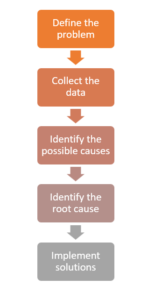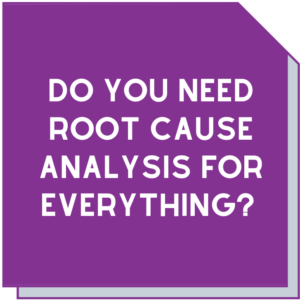Dissection of a NATA condition

Does this happen to you?
You have your NATA assessment and start to deal with the conditions for accreditation. You respond to NATA and their response is:
- written in some unintelligible language (like everything you see coming from NATA)
- seems to say you need to do better and you have 2 weeks to provide a better response
Those things you need to do better are to do with your cause analysis and/or the actions that have been taken.
It happens to more people than you think. And I must sadly admit, once upon a time, I was part of the problem when I worked for NATA and there was the requirement to communicate in “NATA Speak”!
To prevent the hair loss, sighing, and feeling of inadequacy you probably experience, let’s take the guesswork out of the picture. Here are our tips for dealing with the post-assessment phase of a NATA assessment.
Immediate crisis management
 You may jump in and start to just deal with the issue that has been raised. That’s natural to be a “fixer”.
You may jump in and start to just deal with the issue that has been raised. That’s natural to be a “fixer”.
But do you have a clear idea of what the problem is?
Imagine the condition was something like this:
The facility must ensure data transcriptions and calculations are checked.
Follow these steps to manage your initial response
- Start by looking at the condition for accreditation. What does it actually say? Can you clearly relate the condition to the referenced clause in the standard or NATA requirements? If you can’t, then ask the NATA Lead Assessor how the condition is linked to the requirement.
In the example above, it is clear that this condition is linked to the requirement of 7.11.6 in ISO/IEC 17025.
- If the condition can be linked to the requirements, then look again at what it actually says. Do you have enough information to know the specifics of the issue? Ensure that you consult any notes you and your team have from the NATA assessment. It might be the clue you are missing to solve the puzzle.
In the example above, there are no instances or indications where this problem was identified. It could be that in one area of your lab this is perfectly fine. It might also be that you and your staff have no notes from the assessment. When you ask them, your people tell you that they check everything. Hmmm, so this condition doesn’t make any sense.
The solution: go back to the NATA Lead Assessor and ask them for this missing information. What evidence was observed? Those seemingly small details can set you on the right path and will give you the context you need to go through the next steps.
- Then, deal with the problem that was raised as you would normally deal with a problem, just using NATA’s paperwork to record what you have done.
Which brings us to…… the cause analysis part of the paperwork.
Treat the cause, not the symptom of the NATA condition
 The NATA paperwork has a section below the statement of the finding for the Facility Response labelled “Cause Analysis”.
The NATA paperwork has a section below the statement of the finding for the Facility Response labelled “Cause Analysis”.
Without getting to the root of it, the problem will almost certainly recur and need treatment again. That’s why NATA asks for a cause analysis (and because the Standard to which they must conform, ISO 17011, requires them to).
Sometimes they write back to you to say the cause analysis is unsatisfactory. Then you get really confused.
Root cause analysis helps people understand just why the problem occurred in the first place.
Put simply, the techniques used follow a specific series of steps and various tools, that help to find the primary cause of the problem. Using these techniques, you can:
- Work out what happened
- Work out why it happened
- Figure out what you can do to reduce the possibility of it happening again.
Root cause know-how
The process for root cause analysis is pretty clear and we’ve written a couple of articles about this previously. We’ve combined these into a pdf you can download here.
There are a number of tools you can use to support your root cause analysis process. These include cause and effect diagrams and the 5 whys.
A root cause analysis is an essential part of your system-wide review. It will enable you to discover the events and factors leading to significant problems.
But do keep in mind that you also need to know when to stop. In theory, you could probably trace your root cause back to when the business was first established but that wouldn’t be useful at all.
Use your judgment and work back until you find a major cause that can be changed.
The root cause process
Generally, a non-conformance and corrective action process can be explained in five easy steps:
- Define the problem
- Collect the data
- Identify the possible causes
- Identify the root cause
- Implement solutions
Let’s go back to the data transcriptions and calculations check issue at the beginning of the article.
From your additional detective work, you’ve discovered that the problem is that these checks were being done but were not being recorded.
This is a recent problem since you’ve never had this raised before and nobody in the lab has ever recorded this activity over the past 2 years.
Discovering the cause, in this case, is simple and might be labelled as “human error”.
Therefore the solution is simple. You can’t see any problem with the new system, so all you need to do is get people to sign a form as evidence of the check. Root cause analysis done, and problem solved!
Or is it?
 With a deeper investigation you discover events leading to this problem were a combination of new systems of recording and calculating results and digitisation of equipment.
With a deeper investigation you discover events leading to this problem were a combination of new systems of recording and calculating results and digitisation of equipment.
While you have implemented a correction (getting staff to sign a form) you haven’t drilled down to the root of the problem.
Why does the new system of recording and calculating results not allow for recording checks?
What conditions allowed the problem to occur?
What can you do to ensure it doesn’t happen again?
Perhaps the issue needs a little more investigation after all.
When you start digging further, you discover that everyone was so excited at the prospect of going digital that they forgot the change to how data was managed meant some things weren’t automated.
What else is going on to cause this?
Your trusty root cause analysis will help you understand what’s really going on and identify how to fix it. Catch up on how to do this by taking a look through our articles on this topic.
Once you have identified the root cause, then set about setting an action to address it. In the case of our example, it might have been that there was poor change management and brainstorming of the system design by several key lab people. So the corrective action is to review and strengthen those processes of change management and system design which can be done through the development of procedures and other tools to help people in these scenarios. Add these corrective actions to the “Actions” section of the NATA paperwork (and remember to add in the expected completion date for this work).
We can help!
It’s easy to know the theory of what to do, but sometimes you don’t have the time or energy to work through this process. So it’s important to remember that you don’t have to do this alone! We can help you every step of the way with NATA assessments.
If you need help with dealing with conditions for accreditation, NATA assessments, or any catastrophes like this, get in touch with us at info@masmanagementsystems.com.au or call Maree on 0411 540 709.
People who read this also enjoyed




